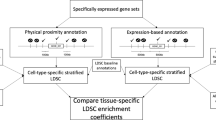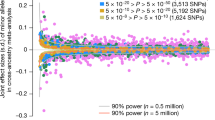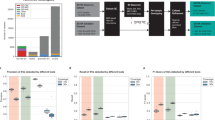Abstract
Linkage disequilibrium (LD)-based association mapping is often performed by analyzing either individual SNPs or block-based multi-SNP haplotypes. Sliding windows of several fixed sizes (in terms of SNP numbers) were also applied to a few simulated or real data sets. In comparison, exhaustively testing based on variable-sized sliding windows (VSW) of all possible sizes of SNPs over a genomic region has the best chance to capture the optimum markers (single SNPs or haplotypes) that are most significantly associated with the traits under study. However, the cost is the increased number of multiple tests and computation. Here, a strategy of VSW of all possible sizes is proposed and its power is examined, in comparison with those using only haplotype blocks (BLK) or single SNP loci (SGL) tests. Critical values for statistical significance testing that account for multiple testing are simulated. We demonstrated that, over a wide range of parameters simulated, VSW increased power for the detection of disease variants by ∼1–15% over the BLK and SGL approaches. The improved performance was more significant in regions with high recombination rates. In an empirical data set, VSW obtained the most significant signal and identified the LRP5 gene as strongly associated with osteoporosis. With the use of computational techniques such as parallel algorithms and clustering computing, it is feasible to apply VSW to large genomic regions or those regions preliminarily identified by traditional SGL/BLK methods.
Similar content being viewed by others
Log in or create a free account to read this content
Gain free access to this article, as well as selected content from this journal and more on nature.com
or
References
Balding DJ : A tutorial on statistical methods for population association studies. Nat Rev Genet 2006; 7: 781–791.
Hirschhorn JN, Daly MJ : Genome-wide association studies for common diseases and complex traits. Nat Rev Genet 2005; 6: 95–108.
Akey J, Jin L, Xiong M : Haplotypes vs single marker linkage disequilibrium tests: what do we gain? Eur J Hum Genet 2001; 9: 291–300.
Zhang K, Calabrese P, Nordborg M et al: Haplotype block structure and its applications to association studies: power and study designs. Am J Hum Genet 2002; 71: 1386–1394.
Cardon LR, Abecasis GR : Using haplotype blocks to map human complex trait loci. Trends Genet 2003; 19: 135–140.
Ding K, Zhou K, Zhang J et al: The effect of haplotype-block definitions on inference of haplotype-block structure and htSNPs selection. Mol Biol Evol 2005; 22: 148–159.
Ke X, Hunt S, Tapper W et al: The impact of SNP density on fine-scale patterns of linkage disequilibrium. Hum Mol Genet 2004; 13: 577–588.
Durrant C, Zondervan KT, Cardon LR et al: Linkage disequilibrium mapping via cladistic analysis of single-nucleotide polymorphism haplotypes. Am J Hum Genet 2004; 75: 35–43.
Cheng R, Ma JZ, Elston RC et al: Fine mapping functional sites or regions from case-control data using haplotypes of multiple linked SNPs. Ann Hum Genet 2005; 69 (Part 1): 102–112.
Cheng R, Ma JZ, Wright FA et al: Nonparametric disequilibrium mapping of functional sites using haplotypes of multiple tightly linked single-nucleotide polymorphism markers. Genetics 2003; 164: 1175–1187.
Mathias RA, Gao P, Goldstein JL et al: A graphical assessment of P-values from sliding window haplotype tests of association to identify asthma susceptibility loci on chromosome 11q. BMC Genet 2006; 7: 38.
Gizatullin R, Zaboli G, Jonsson EG et al: Haplotype analysis reveals tryptophan hydroxylase (TPH) 1 gene variants associated with major depression. Biol Psychiatry 2006; 59: 295–300.
Laws SM, Friedrich P, Diehl-Schmid J et al: Fine mapping of the MAPT locus using quantitative trait analysis identifies possible causal variants in Alzheimer's disease. Mol Psychiatry 2007; 12: 510–517.
Barnes KC, Grant AV, Baltadzhieva D et al: Variants in the gene encoding C3 are associated with asthma and related phenotypes among African Caribbean families. Genes Immun 2006; 7: 27–35.
de Bakker PI, Yelensky R, Pe’er I et al: Efficiency and power in genetic association studies. Nat Genet 2005; 37: 1217–1223.
Weir BS : Genetic Data Analysis II: Methods for Discrete Population Genetic Data. Sunderland, Massachusetts: Siauer Associates Inc. Publishers, 1996.
Gabriel SB, Schaffner SF, Nguyen H et al: The structure of haplotype blocks in the human genome. Science 2002; 296: 2225–2229.
Barrett JC, Fry B, Maller J et al: Haploview: analysis and visualization of LD and haplotype maps. Bioinformatics 2005; 21: 263–265.
Hudson RR : Generating samples under a Wright-Fisher neutral model of genetic variation. Bioinformatics 2002; 18: 337–338.
Huang J, Jiang Y : Genetic linkage analysis of a dichotomous trait incorporating a tightly linked quantitative trait in affected sib pairs. Am J Hum Genet 2003; 72: 949–960.
Zhao J, Jin L, Xiong M : Test for interaction between two unlinked loci. Am J Hum Genet 2006; 79: 831–845.
Zondervan KT, Cardon LR : The complex interplay among factors that influence allelic association. Nat Rev Genet 2004; 5: 89–100.
Xiong DH, Lei SF, Yang F et al: Low-density lipoprotein receptor-related protein 5 (LRP5) gene polymorphisms are associated with bone mass in both Chinese and whites. J Bone Miner Res 2007; 22: 385–393.
Epstein MP, Satten GA : Inference on haplotype effects in case-control studies using unphased genotype data. Am J Hum Genet 2003; 73: 1316–1329.
Gu S, Pakstis AJ, Li H et al: Significant variation in haplotype block structure but conservation in tagSNP patterns among global populations. Eur J Hum Genet 2007; 15: 818.
Falconer DS, Mackay FC : Introduction to Quantitative Genetics, 4th ed. 1996.
International HapMap Consortium: A haplotype map of the human genome. Nature 2005; 437: 1299–1320.
Barrett JC, Fry B, Maller J et al: Haploview: analysis and visualization of LD and haplotype maps. Bioinformatics 2005; 21: 263–265.
Li Y, Sung WK, Liu JJ : Association mapping via regularized regression analysis of single-nucleotide-polymorphism haplotypes in variable-sized sliding windows. Am J Hum Genet 2007; 80: 705–715.
Purcell S, Neale B, Todd-Brown K et al: PLINK: a toolset for whole-genome association and population-based linkage analysis. Am J Hum Genet 2007; 81: 559–575.
Bardel C, Darlu P, Genin E : Clustering of haplotypes based on phylogeny: how good a strategy for association testing? Eur J Hum Genet 2006; 14: 202–206.
Chen GK, Witte JS : Enriching the analysis of genome-wide association studies with hierarchical modeling. Am J Hum Genet 2007; 81: 397–404.
Acknowledgements
We thank Dr Jian-feng Liu for helpful discussion and critical reading of the paper. Investigators of this project were funded in part by Grant no. 30570875 from National Science Foundation of China, Xi’an Jiaotong University, and the Ministry of Education of China; Huo Ying Dong Education Foundation, HuNan Province and Hunan Normal University. HWD was partially supported by grants from NIH (R01 AR050496, R21 AG027110, R01 AG026564, P50 AR055081, and R21 AA015973).
Author information
Authors and Affiliations
Corresponding author
Rights and permissions
About this article
Cite this article
Guo, Y., Li, J., Bonham, A. et al. Gains in power for exhaustive analyses of haplotypes using variable-sized sliding window strategy: a comparison of association-mapping strategies. Eur J Hum Genet 17, 785–792 (2009). https://doi.org/10.1038/ejhg.2008.244
Received:
Revised:
Accepted:
Published:
Issue date:
DOI: https://doi.org/10.1038/ejhg.2008.244
Keywords
This article is cited by
-
Analysis of dog breed diversity using a composite selection index
Scientific Reports (2023)
-
Exploring effective approaches for haplotype block phasing
BMC Bioinformatics (2019)
-
Sliding window haplotype approaches overcome single SNP analysis limitations in identifying genes for meat tenderness in Nelore cattle
BMC Genetics (2019)
-
Loci, genes, and mechanisms associated with tolerance to ferrous iron toxicity in rice (Oryza sativa L.)
Theoretical and Applied Genetics (2015)
-
Genetic association between germline JAK2polymorphisms and myeloproliferative neoplasms in Hong Kong Chinese population: a case–control study
BMC Genetics (2014)



